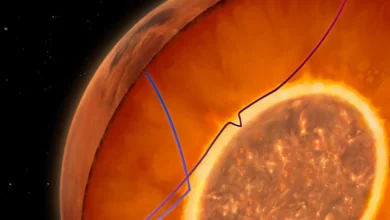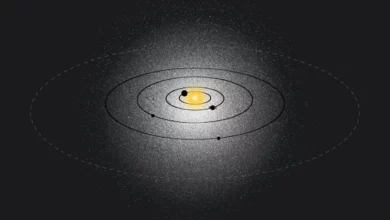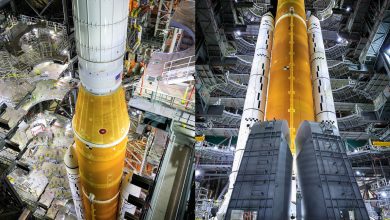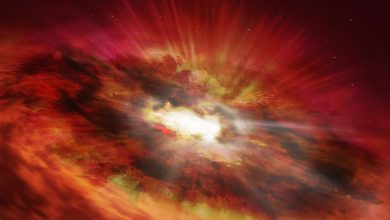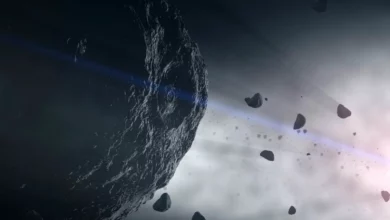
Lead Image: The seven galaxies highlighted in this James Webb Space Telescope image have been confirmed to be at a distance that astronomers refer to as redshift 7.9, which correlates to 650 million years after the big bang. This makes them the earliest galaxies yet to be spectroscopically confirmed as part of a developing cluster.
Astronomers used the telescope’s Near-Infrared Spectrograph (NIRSpec) instrument to precisely measure the distances and determine that the galaxies are part of a developing cluster. Galaxy YD4, previously estimated to be at a further distance based on imaging data alone, was able to be more accurately placed at the same redshift as the other galaxies. Before Webb, astronomers did not have high-resolution imaging or spectral infrared data available to do this type of science.
At extreme distances, astronomers use the redshift reference to account for the fact that, as the universe expands, wavelengths of light are stretched and “shifted” to redder wavelengths, which are longer. Shorter wavelengths, for example ultraviolet and X-ray, are toward the bluer end of the electromagnetic spectrum. So extreme distances in the early universe are referenced by how much the light emitted there has been shifted as it traveled through space to be detected by a telescope.
Credit: NASA, ESA, CSA, Takahiro Morishita (IPAC), Alyssa Pagan (STScI)
Protocluster Confirmed, 650 Million Years after the Big Bang
How did we get here? This fundamental question may be applied on its grandest scale in cosmology, which investigates the history and origin of the universe. Astronomers are able to investigate the early universe and its development like never before with NASA’s James Webb Space Telescope, including the first galaxies.
The powerful telescope’s latest findings are the first to spectroscopically confirm distances for a young protocluster of galaxies just 650 million years after the big bang. Astronomers think the protocluster represents the earliest stages of what will develop into a massive conglomeration like the Coma Cluster, which includes thousands of gravitationally bound member galaxies.
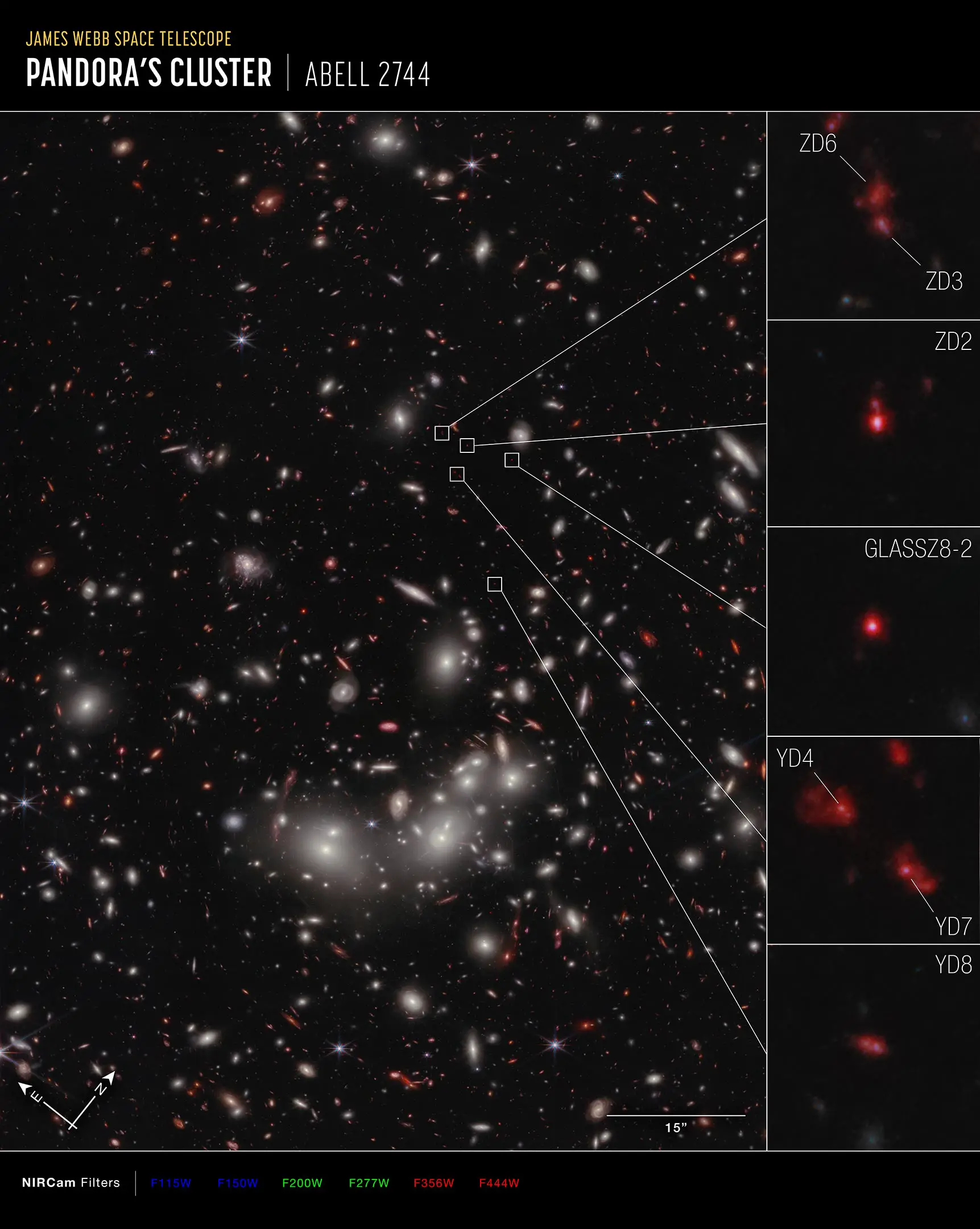
Webb Space Telescope Reveals Early-Universe Prequel to Huge Galaxy Cluster
Every giant was once a baby, though you may never have seen them at that stage of their development. NASA’s James Webb Space Telescope has begun to shed light on formative years in the history of the universe that have thus far been beyond reach: the formation and assembly of galaxies. For the first time, a protocluster of seven galaxies has been confirmed at a distance that astronomers refer to as redshift 7.9, or a mere 650 million years after the big bang. Based on the data collected, astronomers calculated the nascent cluster’s future development, finding that it will likely grow in size and mass to resemble the Coma Cluster, a monster of the modern universe.
“This is a very special, unique site of accelerated galaxy evolution, and Webb gave us the unprecedented ability to measure the velocities of these seven galaxies and confidently confirm that they are bound together in a protocluster,” said Takahiro Morishita of IPAC-California Institute of Technology, the lead author of the study published in the Astrophysical Journal Letters.
The precise measurements captured by Webb’s Near-Infrared Spectrograph (NIRSpec) were key to confirming the galaxies’ collective distance and the high velocities at which they are moving within a halo of dark matter – more than two million miles per hour (about one thousand kilometers per second).
The spectral data allowed astronomers to model and map the future development of the gathering group, all the way to our time in the modern universe. The prediction that the protocluster will eventually resemble the Coma Cluster means that it could eventually be among the densest known galaxy collections, with thousands of members.
“We can see these distant galaxies like small drops of water in different rivers, and we can see that eventually, they will all become part of one big, mighty river,” said Benedetta Vulcani of the National Institute of Astrophysics in Italy, another member of the research team.
This video explains how very distant galaxies are magnified through the phenomenon of gravitational lensing. Gravitational lenses can magnify the light from distant galaxies that are at or near the peak of star formation. This effect allows researchers to study the details of early galaxies too far away to be seen with even the most powerful space telescopes. Credit: NASA, ESA, STScI, Leah Hustak (STScI)
Galaxy clusters are the greatest concentrations of mass in the known universe, which can dramatically warp the fabric of spacetime itself. This warping, called gravitational lensing, can have a magnifying effect for objects beyond the cluster, allowing astronomers to look through the cluster like a giant magnifying glass (see video above). The research team was able to utilize this effect, looking through Pandora’s Cluster to view the protocluster; even Webb’s powerful instruments need an assist from nature to see so far.
Exploring how large clusters like Pandora and Coma first came together has been difficult, due to the expansion of the universe stretching light beyond visible wavelengths into the infrared, where astronomers lacked high-resolution data before Webb. Webb’s infrared instruments were developed specifically to fill in these gaps (see video below) at the beginning of the universe’s story.
Discover how telescopes make it possible to look back in time and study the history of the universe, and how NASA’s James Webb Space Telescope will fill in new details on galaxy evolution over time. The earliest pages of cosmic history are blank, but Webb will allow us to look back farther in time than ever before, helping to fill in the lost pages of the universe’s story. Credit: NASA, ESA, CSA, and L. Hustak and D. Player (STScI)
The seven galaxies confirmed by Webb were first established as candidates for observation using data from the Hubble Space Telescope’s Frontier Fields program. The program dedicated Hubble time to observations using gravitational lensing, to observe very distant galaxies in detail. However, because Hubble cannot detect light beyond near-infrared, there is only so much detail it can see. Webb picked up the investigation, focusing on the galaxies scouted by Hubble and gathering detailed spectroscopic data in addition to imagery.
The research team anticipates that future collaboration between Webb and NASA’s Nancy Grace Roman Space Telescope, a high-resolution, wide-field survey mission, will yield even more results on early galaxy clusters. With 200 times Hubble’s infrared field of view in a single shot, Roman will be able to identify more protocluster galaxy candidates, which Webb can follow up to confirm with its spectroscopic instruments. The Roman mission is currently targeted for launch by May 2027.
“It is amazing the science we can now dream of doing, now that we have Webb,” said Tommaso Treu of the University of California, Los Angeles, a member of the protocluster research team. “With this small protocluster of seven galaxies, at this great distance, we had a one hundred percent spectroscopic confirmation rate, demonstrating the future potential for mapping dark matter and filling in the timeline of the universe’s early development.”
Reference: “Early Results from GLASS-JWST. XIV. A Spectroscopically Confirmed Protocluster 650 Million Years after the Big Bang” by Takahiro Morishita, Guido Roberts-Borsani, Tommaso Treu, Gabriel Brammer, Charlotte A. Mason, Michele Trenti, Benedetta Vulcani, Xin Wang, Ana Acebron, Yannick Bahé, Pietro Bergamini, Kristan Boyett, Marusa Bradac, Antonello Calabrò, Marco Castellano, Wenlei Chen, Gabriella De Lucia, Alexei V. Filippenko, Adriano Fontana, Karl Glazebrook, Claudio Grillo, Alaina Henry, Tucker Jones, Patrick L. Kelly, Anton M. Koekemoer, Nicha Leethochawalit, Ting-Yi Lu, Danilo Marchesini, Sara Mascia, Amata Mercurio, Emiliano Merlin, Benjamin Metha, Themiya Nanayakkara, Mario Nonino, Diego Paris, Laura Pentericci, Piero Rosati, Paola Santini, Victoria Strait, Eros Vanzella, Rogier A. Windhorst and Lizhi Xie, 24 April 2023, Astrophysical Journal Letters.
DOI: 10.3847/2041-8213/acb99e
The James Webb Space Telescope is the world’s premier space science observatory. Webb will solve mysteries in our solar system, look beyond to distant worlds around other stars, and probe the mysterious structures and origins of our universe and our place in it. Webb is an international program led by NASA with its partners, ESA (European Space Agency) and the Canadian Space Agency.

